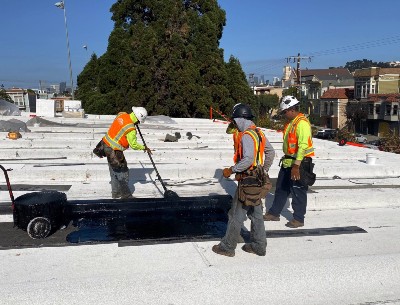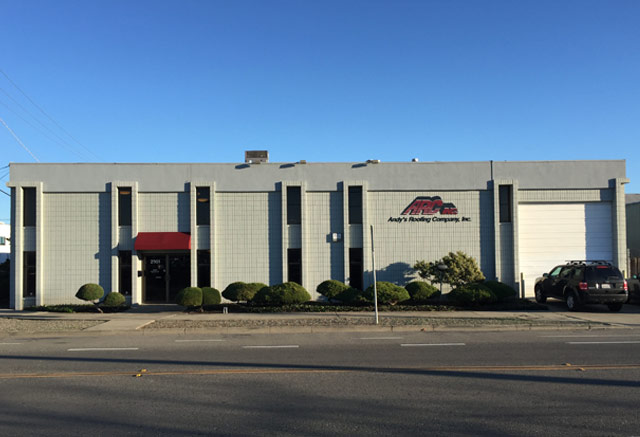Bay Area Built-Up Roofing Contractor
Built-Up Roofing, sometimes referred to as a “tar and gravel” roof, is a tried and true roofing system that has been installed throughout the United States for over 100 years.
These BUR roof systems are usually installed by layering asphalt and reinforcing fabrics to create a watertight roof system. These systems are either “hot-applied” by using a mop to spread 400+ degree asphalt over the roof surface, or “cold applied”, by using solvent-based asphalt adhesives that do not need to be heated in a kettle. Once the asphalt and fabric layers have been installed, Built-Up Roofs can either be covered in a layer of roofing gravel or coated with a bright wight coating to improve the reflectivity of the roof and thermal efficiency of the building.
Andy’s Roofing is an approved applicator for the roofing industry’s leading Built-Up Roofing manufacturers, including:
- GAF
- JM
- Garland
- Firestone
- Malarkey
- Hal Industries
Commonly Asked Questions About Built-Up Roofing
What is a built-up roofing system?
A built-up roofing system, also known as a BUR roof, is a type of roofing system that is constructed by placing layers of roofing felt and asphalt over an approved, fire retardant coverboard.
Because of the many layers of waterproofing materials, built-up roof systems are typically thicker than their single-ply counterparts. Built-up roofs have been around for decades and are considered an industry staple for their durability and longevity.
On a completely flat roof, they do well when paired with a tapered roof insulation system that can help drive water toward the building’s designed drainage system.
How do you install built up roofing?
The first step to install built-up roofing is preparation: you need to make sure your roof is dry, clean and that all the old roofing is removed and any dry rot or failing roof structure is repaired.
Then, after removing any old roofing, lay out the built-up roofing by using asphalt to adhere the plies to an approved fire-retardant coverboard that is either fastened or adhered to the roof deck. The coverboard should be installed over the existing roof deck, and the built-up roofing system placed on top of it.
After the BUR roofing has been installed, exposed nails should be covered with roofing cement and counterflashing.
How much does a tar and gravel roof cost?
The cost of a tar and gravel roof varies depending on the size of the area to be covered, the complexity of the design, and whether the contractor is installing new roofing or repairing an existing roof. The customer also determines much of the final price based on the quality of materials that are chosen.
How long should a tar and gravel roof last?
If installed correctly, a tar and gravel roof can easily last up to 30 years. Built-up roofing systems are the most common type of roofs. While they may look more like something you’d use to pave a road than put on your building, they are actually a very strong and cost-effective way to protect your building’s interior.
How do you replace a tar and gravel roof?
Commercial roofing contractors have two choices when it comes to replacing a tar and gravel roof:
- tear off and replace
- remove the gravel and overlay a new single-ply roof system
This can be a wonderful, cost-effective solution when you are looking to improve the weather protection of your building without incurring the cost to remove the existing roof system.
How do you repair a built up roof?
The first step in repairing a built up roof is to assess the damage. Damage will be caused by one of two problems:
- the roof has too much surface area
- the roofing felt is damaged
If it has too much surface area, you can simply have the surface area removed. This will leave you with a slightly less flat roof, but it will be a lot easier to work with.
If the roofing felt is damaged, you can either replace it or remove it entirely, depending on how big the damaged area is. You can consider replacing the shingles, sealing them with a sealant, and then laying down new shingles over the top of the old roof.
As your roof gets built up with layers of shingles and sealant, you should have a roofer remove the shingles so that you can replace them with new ones.
What type of warranty is included with a built-up roof?
There are two types of roofing warranties: the manufacturer’s warranty, or the installer’s warranty. An installer’s warranty is included from the roofing installer who installed the roof, and is generally for 1 to 5 years. Manufacturer’s warranties on built-up roofing systems range between 15-30 years.
For an additional cost, they will even pay to replace your roof, should the roofing material be defective or otherwise fail before the warranty period is over.

Need a repair or re-roof estimate?
Fill out the form below and we’ll contact you to discuss your project and schedule an estimate.

Andy’s Roofing Co., Inc.
2161 Adams Avenue
San Leandro, CA 94577
Phone: 510-777-1100
Fax: 510-777-1102
